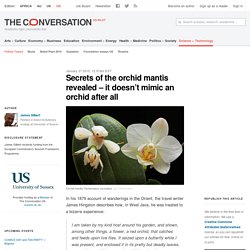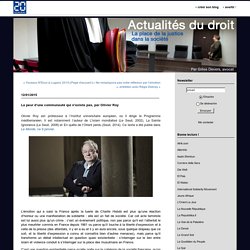

ZONES. Let's dance ! (1/3) C'est le pied Le pied est l’outil essentiel du danseur, l’élément fondamental de sa virtuosité, de sa puissance et de son élégance.

Stability: how life began and why it can’t rest – Addy Pross. Biology is wondrously strange – so familiar, yet so strikingly different to physics and chemistry.

We know where we are with inanimate matter. Ever since Isaac Newton, it has answered to a basically mechanical view of nature, blindly following its laws without regard for purposes. But could there be, as Immanuel Kant put it, a Newton of the blade of grass? Living things might be made of the same fundamental stuff as the rest of the material world – ‘dead’ atoms and molecules – but they do not behave in the same way at all. In fact, they seem so purposeful as to defy the materialist philosophy on which the rest of modern science was built. Even after Charles Darwin, we continue to struggle with that difference. Popular now Game theory’s cure for corruption? Will we ever understand the beginning of the universe? How humans made fire, and fire made us human I believe that it is now possible to bridge that gap. But this is not good enough. The second insight is even more momentous.
El Gran Viaje 4è partie: Puebla - letrangere.over-blog.com. Puebla Le nom de Puebla n'est pas seulement « Puebla », car ce serait vraiment trop simple.

Secrets of the orchid mantis revealed – it doesn't mimic an orchid after all. In his 1879 account of wanderings in the Orient, the travel writer James Hingston describes how, in West Java, he was treated to a bizarre experience: I am taken by my kind host around his garden, and shown, among other things, a flower, a red orchid, that catches and feeds upon live flies.

It seized upon a butterfly while I was present, and enclosed it in its pretty but deadly leaves, as a spider would have enveloped it in network. What Hingston had seen was not a carnivorous orchid, as he thought. But the reality is no less weird or fascinating. He had seen – and been fooled by – an orchid mantis, Hymenopus coronatus, not a plant but an insect. We have known about orchid mantises for more than 100 years. Hiding in plain sight? On the face of it, this is a classic evolutionary story, and a cut-and-dried case: the mantis has evolved to mimic the flower as a form of crypsis – enabling it to hide among its petals, feeding upon insects that are attracted by the flower. Click to enlarge. Why I’m Saying Goodbye to Apple, Google and Microsoft — Backchannel.
Part of my conversion stems from an abiding distaste for corporate and government control-freakery.

If we believe in liberty, we have to realize that we take risks to be more free. If we believe in competition, we sometimes have to intervene as a society to ensure that it’s fair. One way we try to ensure fair competition is enforcement of laws designed to promote it, notably antitrust rules that seek to prevent dominant companies from abusing their dominance. A classic example emerged in the 1990s: Microsoft, a company that had outsmarted and/or outsleazed IBM and everyone else in its rise to pure dominance in the operating system and office “productivity” software markets.
How did science come to speak only English? – Michael D Gordin. If you can read this sentence, you can talk with a scientist.

Well, maybe not about the details of her research, but at least you would share a common language. The overwhelming majority of communication in the natural sciences today – physics, chemistry, biology, geology – takes place in English; in print and at conferences, in emails and in Skype-mediated collaborations, confirmable by wandering through the halls of any scientific research facility in Kuala Lumpur or Montevideo or Haifa. Contemporary science is Anglophone. More significantly, contemporary science is monoglot: everyone uses English almost to the exclusion of other languages. Le sexe du cerveau : pourquoi Catherine Vidal a tort. Où l’on découvre que le message inlassablement répété par Catherine Vidal n'est pas conforme à l'état de la science.

Ce billet est une version légèrement réduite d’un article écrit avec Franck Ramus, qui paraîtra dans la revue Science… et pseudosciences début juillet, au sein d’un dossier sur les différences entre femmes et hommes. La neurobiologiste Catherine Vidal est connue du grand public pour s’exprimer régulièrement sur la question des dissemblances entre hommes et femmes. Son point de vue est qu’il n’existe aucune différence cérébrale ou cognitive notable entre hommes et femmes qui ne puisse s’expliquer par des effets purement culturels.
La peur d’une communauté qui n’existe pas, par Olivier Roy. Olivier Roy est professeur à l’Institut universitaire européen, où il dirige le Programme méditerranéen.

Il est notamment l’auteur de L’Islam mondialisé (Le Seuil, 2002), La Sainte Ignorance (Le Seuil, 2008) et En quête de l’Orient perdu (Seuil, 2014). Ce texte a été publié dans Le Monde, ce 9 janvier. What should ecologists learn LESS of? There are lots of things that it would be nice for ecologists to know more of.

Natural history. Math. Programming. Statistical techniques. The mathematical foundations of statistics. Consultation publique sur la Stratégie Nationale de Recherche. CHOQ - Émissions - L’œuf ou la poule. Que nous réserve la science en 2016 ?

Dans la première de l'année 2016, on fait nos pronostics des évènements scientifiques marquants attendus en 2016. Damien nous dévoile les secrets d'un outils génétique qualifié de révolutionnaire : "CRISPR". Carine revient sur le souhait d'Obama : que l'Amérique trouve une thérapie contre le cancer, "comme ils ont su conquérir la Lune". Élyse Caron-Beaudoin analyse les accords de la conférence de Paris sur le climat, la COP21, en décembre dernier dans sa chronique toxicologie-environnement.
Simon Carrignon nous présente les modèles en science. Nadia Lafrenière et Stéphanie Schanck réalisent une nouvelle chronique mathématiques. Carine Monat partage ensuite son traditionnel agenda scientifique pour commencer l'année 2016 ! Bonne année à toutes et à tous !